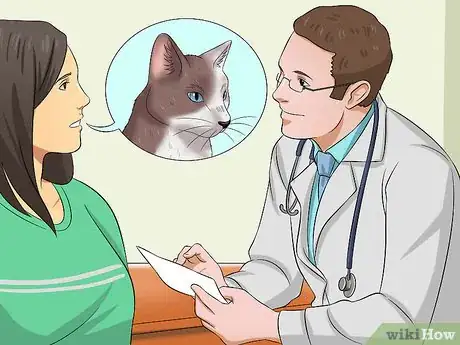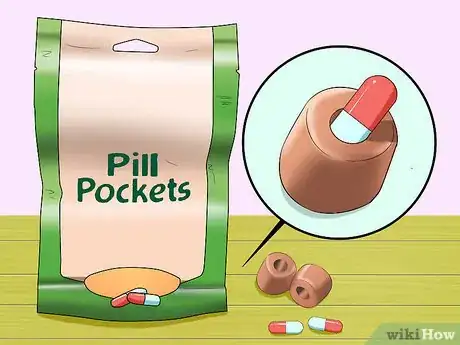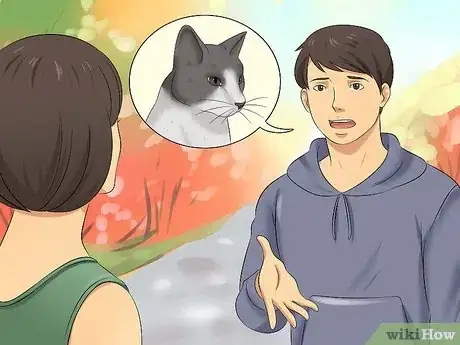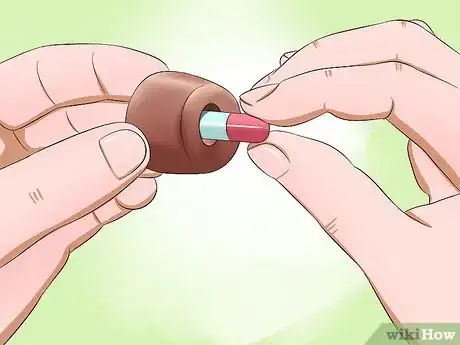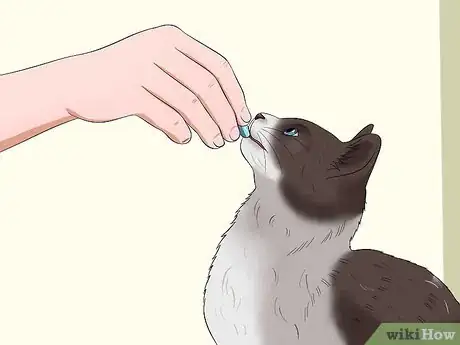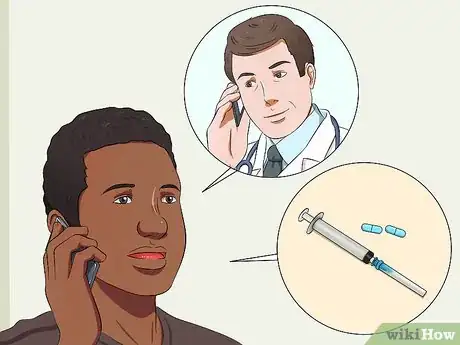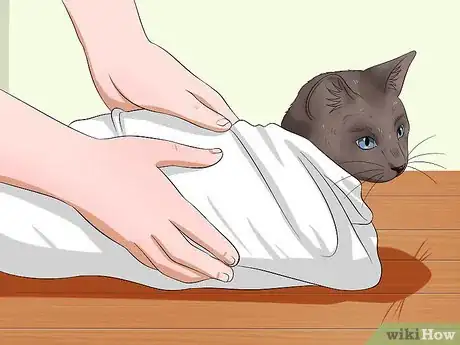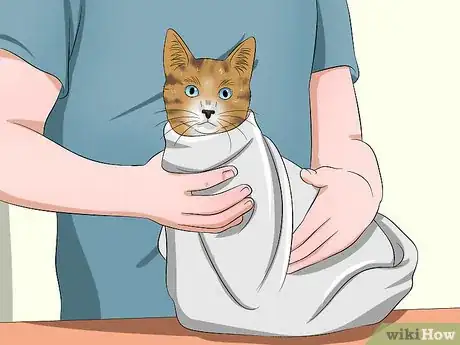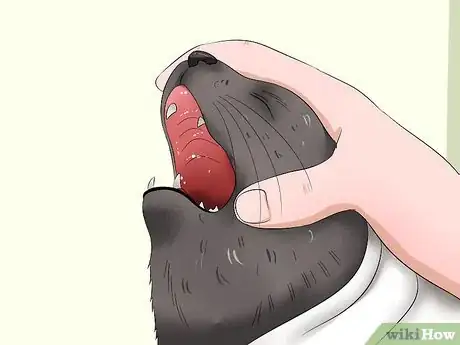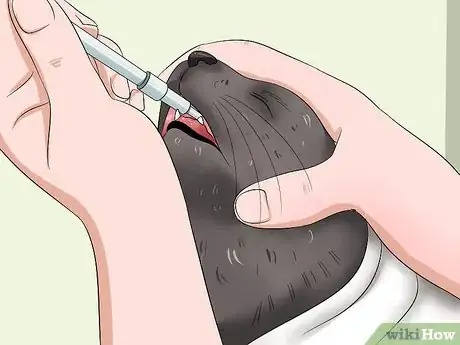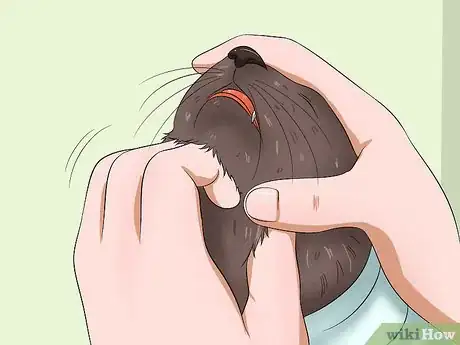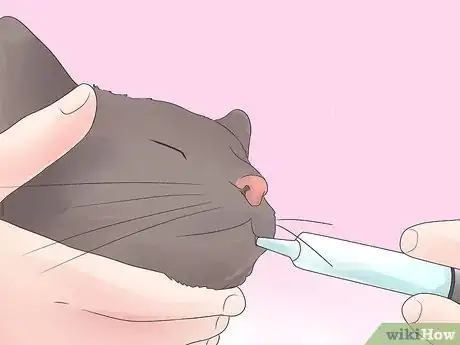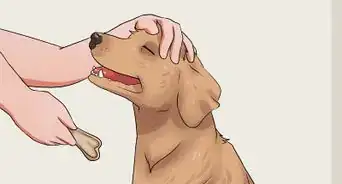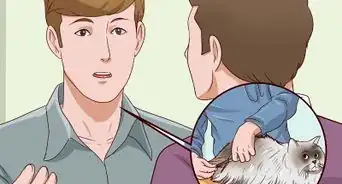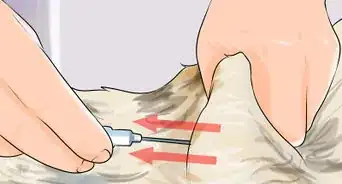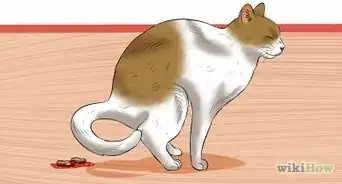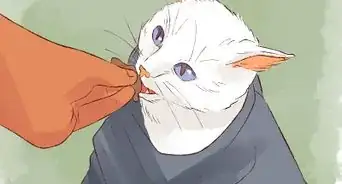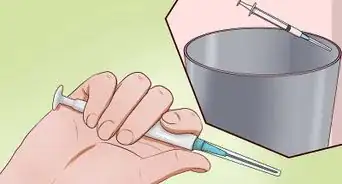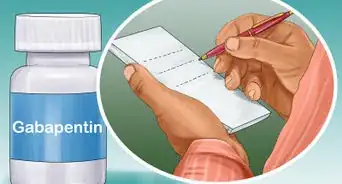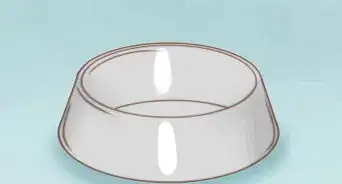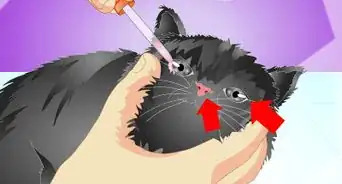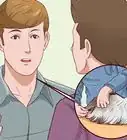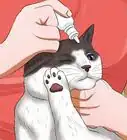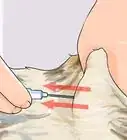This article was co-authored by Pippa Elliott, MRCVS. Dr. Elliott, BVMS, MRCVS is a veterinarian with over 30 years of experience in veterinary surgery and companion animal practice. She graduated from the University of Glasgow in 1987 with a degree in veterinary medicine and surgery. She has worked at the same animal clinic in her hometown for over 20 years.
wikiHow marks an article as reader-approved once it receives enough positive feedback. In this case, several readers have written to tell us that this article was helpful to them, earning it our reader-approved status.
This article has been viewed 349,727 times.
Getting your cat to take its medicine can be a daily struggle, but it is crucial to maintain your cat’s health. If you have been struggling to get your cat to take his medicine, there are a few things that you can do to help make the process a little easier, such as asking for a demonstration by your cat’s veterinarian, using special pill delivery treats, or using a towel to restrain your cat. Keep reading to learn more about how to give a cat medicine.
Steps
Deciding on the Best Method
-
1Talk to your cat’s veterinarian. Before you give any medication to your cat, you should talk to your veterinarian first. Your veterinarian will examine your cat and determine the best course of treatment for his/her condition. If medication is required, your veterinarian will prescribe it and explain how to administer it to your cat. Ask if you are unsure about any of the instructions.[1]
- Ask your veterinarian for a demonstration. If you will be giving your cat pills without food, you may benefit from a demonstration by your veterinarian. Before you leave the vet’s office, ask if he or she can demonstrate how to give the medication to your cat. That will allow you to see the process and ask any questions that you have at the time.
- If your cat is sick, do not attempt to diagnose your cat yourself. Take him to see a veterinarian as soon as possible.
- Never give medicine to your cat that was prescribed for a human, a different cat, or another pet.
-
2Read the medicine instructions carefully. Before you administer the medication to your cat, read the instructions carefully and make sure that you understand them. If you have any questions or concerns about the medication, call your cat’s veterinarian.[2] Some questions you may want to ask your veterinarian include:
- What time should the medication be given?
- Should the medication be given with or without food?
- How should the medication be given? By mouth? By injection?
- Can I crush the medication?
- What are the potential side effects of this medication?
- How do I keep myself safe when administering the medication? Should I wear gloves?
Advertisement -
3Decide how to administer your cat’s medicine. Before you give your cat the medicine, make sure that you are clear on the best way to give the medication. If you are able to give your cat his medicine with food, that will be the easiest and most pleasant method for both of you.[3]
- With Food If the medication can be taken by mouth with food, then your best option is to use Pill Pockets or another type of food that your cat likes. You may need to experiment with different types of food before you find something that your cat really likes.
- Without Food If your cat needs to take his medication on an empty stomach, you will need to use a pill syringe or carefully place the pill in your cat’s mouth while you restrain him. If you need to administer a liquid medicine, you will need to use a medicine dropper to put the medicine into your cat’s mouth while you restrain him.
Administering Medicine With Food
-
1Purchase some special treats meant for medicine administration. If your cat can take his medication with food, your best bet is to use a commercial product like Pill Pockets to coat your cat’s pills. You can find Pill Pockets in pet stores. If you cannot find pill pockets or if your cat does not like them, try using wet cat food to make tiny meatballs to coat your cat’s pills.[4]
- You can also look for Flavor Doh, which is another brand of pill concealing treats.
-
2Find out if you can crush the medication. It is much easier to mix a powder in with a strong-flavored food (to hide the taste) than administer a pill; however, be aware not all pills are suitable for crushing. If the pill is a slow-release pill, crushing it will destroy this property, making an overdose possible. Or crushing it may simply make it taste unpleasant, and your cat will taste it and reject the food.
-
3Prepare the treats. Put your cat’s pill into a Pill Pocket or Flavor Doh. Make sure that the treat is sticking to the pill so that your cat will not be able to separate the pill from the treat. Have a few other non-medicine treats ready to give your cat after he eats the pill treat.[5]
- If you are using wet cat food instead, make four tiny meatballs using a cat food that your cat likes and then insert one of the pills into one of the meatballs. Keep track of which meatball you put the pill into!
-
4Give the treats. Give your cat the treats you have prepared in a location that he likes, such as where he normally eats or a favorite roosting spot.[6] If you are using the Pill Pockets or Flavor Doh, simply give your cat the treat and make sure he eats it. If he spits it out, you can try again with a new treat or use wet cat food to make tiny meatballs.
- To give your cat the treat using the wet cat food, give him two of the four meatballs that do not contain the pill. Then, give him the pill meatball and wait for him to swallow it. Follow up with the last non-medicine meatball to help get the medicine taste out of his mouth. The last non-medicine meatball will prevent him from associating the cat food with a bad taste, which will make it easier to keep using this method.
-
5Follow up with a medicine-free treat. After your cat has taken his treat using either method, make sure to follow up by giving him one of his favorite treats. You can also pet him and play with him if he is feeling up to it. Just do whatever you can to make the experience pleasant for him so that he looks forward to taking his medicine in the future.[7]
- Be aware that some cats develop an aversion to the food containing the pill. Try to avoid "pilling" with a food your cat relies on, in case they refuse to eat it in future because they link it to a pill.
Administering Medicine Without Food
-
1Prepare the medicine. Before you restrain your cat, you will need to get his medicine ready to go. If you have not done so already, read the medicine label carefully before you prepare your cat’s medicine. Call your cat’s veterinarian if you have any questions about how to administer the medicine.[8]
- Your vet may give you a pill pusher if you will be administering pills without food. A pill pusher is like a syringe for pills, so that you do not have to stick your fingers into your cat’s mouth. If your cat will be taking liquid medicine, your will need to use a medicine dropper.
- Double check the dosage for your cat’s medicine and make sure that you have prepared the correct amount.
- If your cat has to take a pill without food, prepare a medicine dropper with about 5 milliliters (0.2 fl oz) of water as well. You can give this water to your cat after administering the pill to ensure that your cat swallows the pill and it doesn’t get stuck in his esophagus.[9]
- Place your cat’s medicine someplace close to where you will be holding your cat, so that you can grab it as soon as the cat's mouth is open. For example, you could place the medicine on a paper towel on a nearby surface or ask someone to hold it for you.
-
2Wrap your cat in a towel with only his head exposed. Wrap your cat up like a burrito by placing him onto the middle of the towel and quickly pulling the sides up around him. If you have to administer a pill to your cat without food, you will have to restrain him and put the pill into his mouth. If your cat is not used to taking pills, then there is a good chance that he will struggle to get free. By wrapping him in a towel with only his head exposed, you can prevent him from finding traction on your body and getting away from you. The towel will also help to prevent him from scratching you.[10]
- You can also try holding your cat in your lap while you administer the medicine, if that feels easier for you. You should still wrap your cat in a towel because there is still a good chance that he will try to get away.[11]
- You may also want to enlist the help of a friend or family member if this is a new experience for your cat. That way, one of you can hold your cat and the other can administer the medicine with both hands.
-
3Use an elevated surface such as a high counter, dresser, or washing machine. Any surface that is at least waist high will make it easier for you to administer your cat’s medication. Hold your cat (still wrapped in the towel) while allowing his body to rest on the surface.[12] If you are administering the medicine by yourself, you will want to have one hip against the side of the surface and your arm around your cat.
-
4Open the cat's mouth. Use your thumb and ring finger to press the corners of your cat’s mouth. Your cat’s mouth should begin to open as you apply pressure. If your cat’s mouth is not opening wide enough to give the medicine, use your other hand to gently push down on your cat’s lower jaw.[13]
- Do your best to keep your fingers out of your cat’s mouth as you hold it open. Keep them on the edges of his mouth so that they are out of the reach of his teeth.
-
5Put the medication in the cat's mouth. If you are using a pill pusher, put the pill towards the back of your cat’s tongue. If you are using a medicine dropper, insert the dropper between the cat's cheek and teeth. Do not squirt liquid medication into the cat's throat or tongue. Liquids are likely to go down a cat's windpipe, making the cat choke.[14]
- Follow up with the 5 milliliters (0.17 fl oz) medicine dropper of water if you are give your cat a pill without food. Make sure to administer the water between your cat’s cheek and teeth.
-
6Close your cat’s mouth and stroke his throat. After you have administered the medicine, close your cat’s throat and gently stroke his throat under his chin. This will help to encourage him to swallow the pill.[15]
-
7Reward your cat for his cooperation. Even though you cannot give your cat a treat to reward him for taking his medicine, you should still do something to let him know you are happy with him. Pet him, play with him, and praise him immediately after you finish giving your cat his medicine.
-
8Provide your cat with water. Give your cat a drink or syringe a small volume of water into the side of his mouth (remember not to squirt straight into the cat's throat or onto tongue, as the water will likely end up down his windpipe). This washes the pill down so that it doesn't get stuck halfway down the esophagus. Some meds can burn if they get stuck, with potentially serious consequences.
Expert Q&A
-
QuestionCan we give thyroid meds with baby aspirin?
 Pippa Elliott, MRCVSDr. Elliott, BVMS, MRCVS is a veterinarian with over 30 years of experience in veterinary surgery and companion animal practice. She graduated from the University of Glasgow in 1987 with a degree in veterinary medicine and surgery. She has worked at the same animal clinic in her hometown for over 20 years.
Pippa Elliott, MRCVSDr. Elliott, BVMS, MRCVS is a veterinarian with over 30 years of experience in veterinary surgery and companion animal practice. She graduated from the University of Glasgow in 1987 with a degree in veterinary medicine and surgery. She has worked at the same animal clinic in her hometown for over 20 years.
Veterinarian Aspirin is toxic to cats, except in minuscule doses (such as prescribed by a vet if the cat is at risk of developing blood clots.) In this case, you can give both doses of meds together. However, the general rule is never to give a cat aspirin, as even a single tablet could kill a cat.
Aspirin is toxic to cats, except in minuscule doses (such as prescribed by a vet if the cat is at risk of developing blood clots.) In this case, you can give both doses of meds together. However, the general rule is never to give a cat aspirin, as even a single tablet could kill a cat. -
QuestionWhat can I do if my cat scratches and bites when I wrap her in a towel?
 Pippa Elliott, MRCVSDr. Elliott, BVMS, MRCVS is a veterinarian with over 30 years of experience in veterinary surgery and companion animal practice. She graduated from the University of Glasgow in 1987 with a degree in veterinary medicine and surgery. She has worked at the same animal clinic in her hometown for over 20 years.
Pippa Elliott, MRCVSDr. Elliott, BVMS, MRCVS is a veterinarian with over 30 years of experience in veterinary surgery and companion animal practice. She graduated from the University of Glasgow in 1987 with a degree in veterinary medicine and surgery. She has worked at the same animal clinic in her hometown for over 20 years.
Veterinarian Speak to your vet to see if an alternative medication in a more palatable form, or as an injection is appropriate. If it's essential to continue, then try enlisting the help of a friend to wrap the cat. This will make you more slick at the procedure, giving the cat less opportunity to wriggle and bite.
Speak to your vet to see if an alternative medication in a more palatable form, or as an injection is appropriate. If it's essential to continue, then try enlisting the help of a friend to wrap the cat. This will make you more slick at the procedure, giving the cat less opportunity to wriggle and bite. -
QuestionHow long should I wait to feed my cat after giving Ascaten-P pills?
 Pippa Elliott, MRCVSDr. Elliott, BVMS, MRCVS is a veterinarian with over 30 years of experience in veterinary surgery and companion animal practice. She graduated from the University of Glasgow in 1987 with a degree in veterinary medicine and surgery. She has worked at the same animal clinic in her hometown for over 20 years.
Pippa Elliott, MRCVSDr. Elliott, BVMS, MRCVS is a veterinarian with over 30 years of experience in veterinary surgery and companion animal practice. She graduated from the University of Glasgow in 1987 with a degree in veterinary medicine and surgery. She has worked at the same animal clinic in her hometown for over 20 years.
Veterinarian Having an empty stomach enhances the absorption of this dewormer across the stomach wall and into the blood stream. Wait a couple of hours after giving the tablet before you feed so that the presence of food in the stomach doesn't decrease the effectiveness.
Having an empty stomach enhances the absorption of this dewormer across the stomach wall and into the blood stream. Wait a couple of hours after giving the tablet before you feed so that the presence of food in the stomach doesn't decrease the effectiveness.
Warnings
- Do not give your cat human medicine. It can be harmful or fatal!⧼thumbs_response⧽
- Do not give a cat any medicine that was not prescribed by a veterinarian. If you know your cat has a condition that requires an antacid, consult your vet about appropriate medicines and dosage.⧼thumbs_response⧽
References
- ↑ http://pets.webmd.com/cats/guide/give-medications-cat
- ↑ http://www.vcahospitals.com/main/cat-care/article/how-to-give-your-cat-a-pill
- ↑ http://pets.webmd.com/cats/guide/give-medications-cat
- ↑ http://pets.webmd.com/cats/guide/give-medications-cat
- ↑ http://pets.webmd.com/cats/guide/give-medications-cat
- ↑ https://www.aspca.org/pet-care/virtual-pet-behaviorist/cat-behavior/giving-your-cat-pill
- ↑ http://www.vcahospitals.com/main/cat-care/article/how-to-give-your-cat-a-pill
- ↑ http://pets.webmd.com/cats/guide/give-medications-cat
- ↑ http://pets.webmd.com/cats/guide/give-medications-cat
- ↑ http://pets.webmd.com/cats/guide/give-medications-cat
- ↑ http://www.vcahospitals.com/main/cat-care/article/how-to-give-your-cat-a-pill
- ↑ http://www.vetstreet.com/cats/administering-injectable-medication-to-your-cat
- ↑ http://pets.webmd.com/cats/guide/give-medications-cat
- ↑ http://pets.webmd.com/cats/guide/give-medications-cat
- ↑ http://pets.webmd.com/cats/guide/give-medications-cat
- ↑ https://www.aspca.org/pet-care/virtual-pet-behaviorist/cat-behavior/giving-your-cat-pill
About This Article
To give a cat medicine with food, start by getting some special treats, like wet cat food or Pill Pockets. If you can crush the medicine, mix the powder in with the food. However, if the medicine is a slow-release pill, place it in the center of a sticky treat and feed it to your cat. Alternatively, to give your cat medicine without food, wrap your cat in a towel with its head exposed, open its mouth, and put the pill or liquid toward the back of the tongue. Then, close your cat’s mouth, stroke its neck, and give it a dropper full of water. For more tips from our Veterinarian reviewer, including the best place in your house to give your cat medicine, keep reading!
